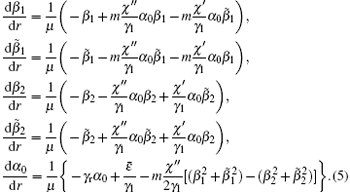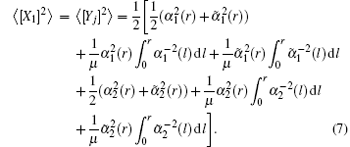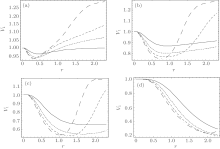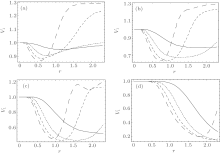†Corresponding author. E-mail: zchy49@hdu.edu.cn
*Project supported by the State Key Laboratory of Quantum Optics and Quantum Optics Devices, Shanxi University, Taiyuan 030006, China (Grant No. KF201401) and the National Natural Science Foundation of China (Grant No. 11404084).
Based on the quantum fluctuations, we adopt the method of generalized V1 criterion to investigate multipartite entanglement characteristics in an optical parametric amplification system with the consideration of dispersion. The nonlinear interaction becomes strong because of the existence of dispersion coefficient σ . Considering the influence of dispersion factor σ , with increasing the pump parameter μ , the value of minimum variance V1 decreases and the squeezing curve nearly equals 1/(1 + μ ). The larger particle number N results in a smaller variance and higher entanglement.
The continuous variable (CV) entanglement light has been an interesting research subject theoretically and experimentally, as it could be used as a basic resource for this new type of information processing.[1] The experimental achievements include demonstrations of quantum teleportation, [2] quantum dense coding, [3] and quantum cryptographic communication[4] by using the squeezed light. The bipartite CV entanglement states of a light field were studied in Refs. [5] and [6] and demonstrated experimentally[7] for a non-degenerate optical parametric amplifier (NOPA). The production of tripartite CV entangled beams by mixing squeezed states with linear optical elements can be found in Refs. [8]– [13]. The genuine four-partite CV entanglement has been experimentally generated.[14] Pfister et al. proposed multipartite CV entanglement from concurrent nonlinearities through the generalization of bipartite interaction Hamiltonian 

At present, the squeezing and entanglement of pulse frequency combs have attracted a great deal of attention because of their potential applications in quantum communication. The dispersion is one of the critical factors. In order to avoid the dispersion effect, the interaction lengths may be restricted to being very short, which limits the degree of squeezing.[18– 21] Takahashi et al. investigated the effects of dispersion on both quadrature squeezing and photon statistics by varying the interaction length when pumping a PPLN crystal with fs pulses.[22] We studied the phase mismatched phenomenon resulting from the dispersion effect, by periodically changing the polarity of crystal to obtain the optimal squeezing condition, and obtained the characteristic of EPR entanglements.[23] In this paper, we discuss the influence of the dispersion effect, find the solution of the time-dependent FPE with the dispersion, and investigate the entanglement characteristics for N = 2– 5 partite. The investigation is especially important for the pulse OPO and the quantum characteristics of pulse frequency combs.
The Hamiltonian describing this system for multipartite entanglement is

where

According to the non-degenerate mode operators b1, … , bN obtained by Ref. [17] and the standard technique, [24] we define α j = 〈 bj〉 , j = 1 ∼ N, α 0 = 〈 a0 〉 . Assuming the dynamic equation to have the initial values α 10 = α 20 = · · · = α N0 = 1, α 00 = 0, we have α 1 = α 2 = · · · = α N . Considering the interaction between the medium and the optical field, we have the nonlinear susceptibility χ = χ ′ + iχ ″ , where χ ′ is the revised refractive index, χ ″ is the gain, the dispersion effect is neglected, and only the imaginary part χ ″ is retained. The semi-classical equations describing the interactions between pump wave α 0 (τ ) and parametric waves α 1 (τ ), α 2 (τ ) become[25]

Here τ = γ 1t is the dimensionless time, γ 1 and γ 2 are the damping rates, and decay ratio γ r = γ 2/γ 1, 
Considering the influence of dispersion,

is the dielectric coefficient, the refractive index of the nonlinear susceptibility is

the real part n′ denotes the revised refractive index when the light with different frequencies passes through a medium, whereas the imaginary part n″ denotes the gain.[23] When α 1 = α 2, in terms of Eq. (2), the semi-classical equation for the DOPA system becomes

Assuming α 0 to be real and writing the complex α 1 as 

We take the parameters 


 | Fig. 1. Relations among the pump wave α 0 (solid line), steady state value  |
Figures 1(a) and 1(b) describe the relations among pump wave α 0, steady state value 



Considering the effect of dispersion, according to Eq. (2), the complex 


Considering the initial condition 



The quantum fluctuation of the time-dependent linearly driven NOPA system is[27]

The correlation between X1 and Y2 is


The variance criterion V1 is[23]

In the following, we investigate the influence of dispersion on multipartite entanglement. (i) μ = 0.5 for below-threshold, (ii) μ = 1 for the threshold, (iii) μ = 2 for the above-threshold, and (iv) μ = 10 for far-above-threshold. The results of numerical calculation of V1 versus r with η = 1/1000 and γ r = 10 for N = 2– 5 are depicted in Figs. 2 and 3.
Figures 2 and 3 depict the minimum variance V1 as a function of squeezing parameter r = μ τ for σ = 0, 1, respectively. From bottom to top, the plots are for bipartite entanglement (N = 2, solid curve), tripartite entanglement (N = 3, narrow dashed curve), four-particle entanglement (N = 4, wide dashed curve), and five-particle entanglement (N = 5, dashed– dotted curve). Given dispersion factor σ , with the increase of pump parameter μ , the value of minimum variance V1 decreases. Comparing Fig. 3 with Fig. 2, the scope of entanglement decreases from 10 to 2. The phase increases with the increase of pump parameter μ , namely φ = μ r = 10 × 1.5 ≈ 5π , the polarity of gain medium changes many times, the net gain descends as shown in Figs. 2 and 3.
In this paper, we investigate the multipartite entanglement of FNOPA system with considering the effect of dispersion, the results are as shown in Figs. 1– 3. The nonlinear interaction becomes strong due to dispersion coefficient σ . With the increase of pump parameter μ , the minimum variance V1 decreases. The minimum variance V1 decreases with the increase of the number N of particles.
| 1 |
|
| 2 |
|
| 3 |
|
| 4 |
|
| 5 |
|
| 6 |
|
| 7 |
|
| 8 |
|
| 9 |
|
| 10 |
|
| 11 |
|
| 12 |
|
| 13 |
|
| 14 |
|
| 15 |
|
| 16 |
|
| 17 |
|
| 18 |
|
| 19 |
|
| 20 |
|
| 21 |
|
| 22 |
|
| 23 |
|
| 24 |
|
| 25 |
|
| 26 |
|
| 27 |
|




